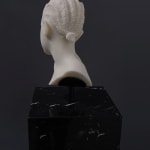-
Artworks
Esmaa Mohamoud Canadian, b. 1992
Ebony in Ivory, I, 2022Shea Butter, Italian black marble, wax, damar resin60 x 30 x 30 in (installed)
152.4 x 76.2 x 76.2 cm (installed)Unique Edition 4 of 5 (+1AP)8704Further images
-
(View a larger image of thumbnail 1
)

-
(View a larger image of thumbnail 2
)

-
(View a larger image of thumbnail 3
)

-
(View a larger image of thumbnail 4
)

-
(View a larger image of thumbnail 5
)

-
(View a larger image of thumbnail 6
)

-
(View a larger image of thumbnail 7
)

-
(View a larger image of thumbnail 8
)

-
(View a larger image of thumbnail 9
)

This sculpture by Esmaa Mohamoud depict the bust of a young African girl, carved out of shea butter. The bust sits atop a plinth of black Italian marble. At its...This sculpture by Esmaa Mohamoud depict the bust of a young African girl, carved out of shea butter. The bust sits atop a plinth of black Italian marble. At its foot is a pile of shoe butter “shea nuts,” made from hand whittled casts of real Ghanaian shea nuts. The intricate, masterful bust offers a simultaneous expression of beauty, intense labor, and objectification—an apt and eloquent commentary on the shea butter industry itself. Shea butter is among Africa’s largest exports, and is used extensively in common beauty products. While the companies that utilize this raw material make exorbitant profits, the young African women who harvest shea nuts are ruthlessly exploited, making a meager living and working long hours. For example, Ghana is one of the largest shea butter exporting countries, producing around 130,000 tons of shea butter per year. According to a recent report by the Huffington Post, it is estimated that more than three million rural Ghanaian women work in the industry (one in five Ghanaian women), with a typical worker earning the equivalent of about two dollars after working a five day week.1of 2 -
(View a larger image of thumbnail 1
)








